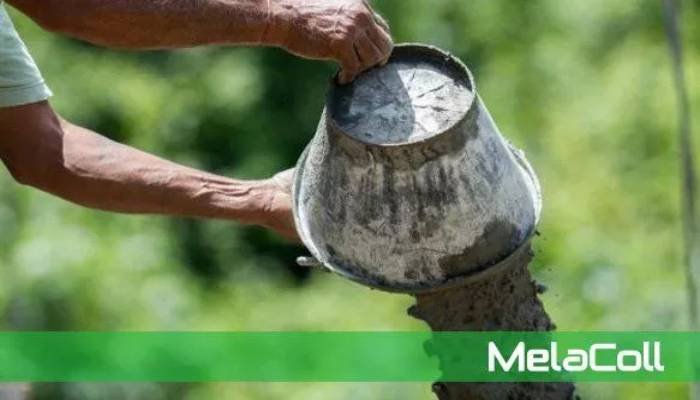
Met de ontwikkeling van moderne bouwconstructies worden de prestaties van cellulose-ethers nauw gecombineerd met mortel. Cellulose-ethers worden gevormd door verestering van cellulose of een of meer ethervormers en droog malen. MelaColl™ cellulose-ether producten zijn onder andere HPMC, HEMCen HECzijn multifunctionele additieven die op grote schaal worden gebruikt in cementproducten. Factoren die verband houden met de eigenschappen van cellulose-ethers worden een veelbesproken onderwerp in de industrie.
 Verschillende soorten waterige oplossingen van cellulose-ethers geleren bij verschillende temperaturen. De gel is volledig omkeerbaar en vormt een oplossing bij afkoeling. Cellulose-ethers hebben unieke omkeerbare thermische geleringseigenschappen. In veel cementproducten wordt voornamelijk gebruik gemaakt van de viscositeitsperforcemant van cellulose-ethers en de bijbehorende waterretentie en smeereigenschappen, en de viscositeit is direct gerelateerd aan de geleertemperatuur. Onder de gelatietemperatuur geldt: hoe hoger de viscositeit van de cellulose-ether, hoe beter het watervasthoudende vermogen.
Verschillende soorten waterige oplossingen van cellulose-ethers geleren bij verschillende temperaturen. De gel is volledig omkeerbaar en vormt een oplossing bij afkoeling. Cellulose-ethers hebben unieke omkeerbare thermische geleringseigenschappen. In veel cementproducten wordt voornamelijk gebruik gemaakt van de viscositeitsperforcemant van cellulose-ethers en de bijbehorende waterretentie en smeereigenschappen, en de viscositeit is direct gerelateerd aan de geleertemperatuur. Onder de gelatietemperatuur geldt: hoe hoger de viscositeit van de cellulose-ether, hoe beter het watervasthoudende vermogen.
Cellulose-ethers in cementproducten worden voornamelijk gebruikt als verdikkingsmiddel, weekmaker en watervasthoudend middel. Viscositeit en geltemperatuur zijn dus belangrijke factoren om de prestaties van cellulose-ethers te controleren.
Cementsystemen zijn systemen met uiterst complexe fysische en chemische eigenschappen. De temperatuur en viscositeit van de cellulose-ethergel worden beïnvloed door vele factoren, en de invloedstendens en -graad zijn verschillend. Daarom moet bij het kiezen van cellulose-etherproducten rekening worden gehouden met factoren die veranderingen in de gel-temperatuur veroorzaken.De viscositeit en gel-temperatuur is een belangrijke eigenschap van cellulose-ethers. De belangrijkste factoren die de viscositeit en gel temperatuur prestaties van cellulose-ethers oplossing in cementproducten zijn als volgt:
1. Het effect van pH op viscositeit
Aangezien MC en HPMC niet-geïoniseerd zijn, heeft de viscositeit van hun oplossingen meestal een bredere pH-stabiliteitsprestatie van cellulose-ethers dan die van natuurlijk ionisch rubber. Toch, als de pH-waarde hoger is dan 3 tot 11, zijn ze bij hogere temperaturen of na langdurige opslag. De viscositeit zal geleidelijk afnemen, vooral in oplossingen met een hoge viscositeit. De viscositeit van de oplossing van cellulose-ether in een sterk zure of alkalische oplossing neemt af, voornamelijk omdat alkali en zuur de uitdroging van de cellulose-ether bevorderen. Daarom neemt de viscositeit van cellulose-ethers meestal in zekere mate af in de alkalische omgeving van het cementproduct.

2. Effect van verwarmingssnelheid en roeren op het gelproces
De gelpuntstemperatuur van cellulose-ethers is een combinatie van de verwarmingssnelheid en de afschuifsnelheid van de agitatie. Hogesnelle agitatie en snelle verwarming resulteren meestal in een aanzienlijke stijging van de geltemperatuur, wat voordelig is voor het mechanisch mengen van cementproducten.
3. Effect van concentratie op thermische gel
Een verhoging van de concentratie van de oplossing verlaagt over het algemeen de geltemperatuur en het gelpunt van cellulose-ether met een lage viscositeit is hoger dan dat van cellulose-ether met een hoge viscositeit.
4. Effect van additieven op de thermische gelprestaties van cellulose-ethers
Veel materialen op het gebied van bouwmaterialen zijn anorganische zouten, die de gel-temperatuur van de cellulose-etheroplossing aanzienlijk kunnen beïnvloeden. Sommige additieven kunnen de thermogeleertemperatuur van cellulose-ether verhogen. Andere daarentegen kunnen de thermogeleertemperatuur van de cellulose-ether verlagen, afhankelijk van of de additieven coagulatie of solubilisatie bevorderen.
Bijvoorbeeld het oplosmiddel ethanol, PEG 400 (polyethyleenglycol), propyleenglycol, enz. kunnen het gelpunt verhogen. Zouten, glycerine en sorbitol verlagen het gelpunt. Niet-ionische cellulose-ethers slaan meestal niet neer als gevolg van meerwaardige metaalionen.
Als de concentratie elektrolyt of andere opgeloste stoffen echter een bepaalde grens overschrijdt, zal het cellulose-etherproduct in oplossing uitzouten, wat te wijten is aan de concurrentie van het elektrolyt om water, wat leidt tot een verminderde hydratatie van de cellulose-ether en het uitzouten van het cellulose-etherproduct. De hoeveelheid zout in de oplossing van het HPMC-product is over het algemeen iets hoger dan in het MC-product en het zoutgehalte in verschillende HPMC's verschilt enigszins.
Samengevat hebben viscositeit en geltemperatuur een essentiële invloed op het beheersen van de prestaties van cellulose-ethers. Daarom moet bij het gebruik van cellulose-ethers in cementproducten bij voorkeur rekening worden gehouden met viscositeit en gel-temperatuur. We hebben verschillende soorten cellulose-ethers ontwikkeld voor verschillende cementproducten. KLIK HIER voor meer informatie of CONTACT ONS voor een monster!


Laat een reactie achter